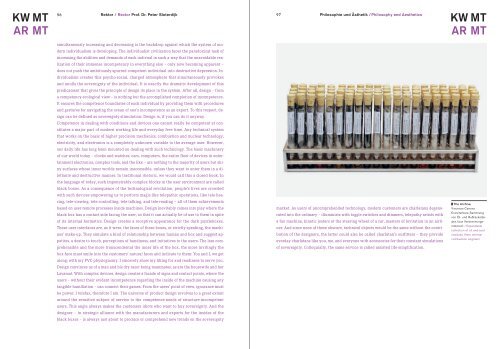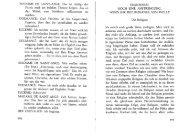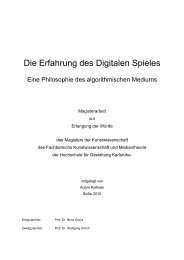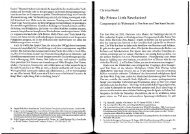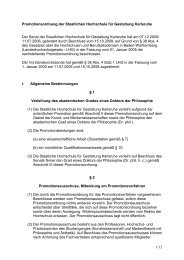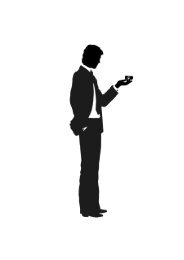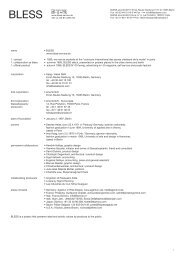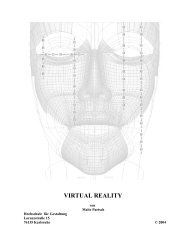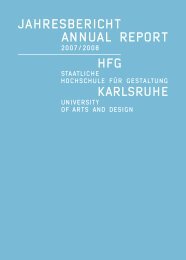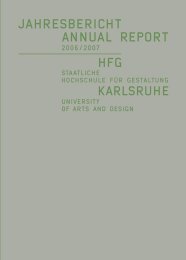HfG Karlsruhe Jahresbericht Staatliche Hochschule für Gestaltung ...
HfG Karlsruhe Jahresbericht Staatliche Hochschule für Gestaltung ...
HfG Karlsruhe Jahresbericht Staatliche Hochschule für Gestaltung ...
Sie wollen auch ein ePaper? Erhöhen Sie die Reichweite Ihrer Titel.
YUMPU macht aus Druck-PDFs automatisch weboptimierte ePaper, die Google liebt.
KW MT<br />
AR MT<br />
96 Rektor / Rector Prof. Dr. Peter Sloterdijk 97<br />
Philosophie und Ästhetik / Philosophy and Aesthetics<br />
simultaneously increasing and decreasing is the backdrop against which the system of mo-<br />
dern individualism is developing. The individualist civilization faces the paradoxical task of<br />
increasing the abilities and demands of each indivual in such a way that the unavoidable rea-<br />
lization of their immense incompetency in everything else – only now becoming apparent –<br />
does not push the ambitiously-spurred competent individual into destructive depression. Individualism<br />
creates this psycho-social, charged atmosphere that simultaneously provokes<br />
and anulls the sovereignty of the individual. It is exactly the dramatic development of this<br />
predicament that gives the principle of design its place in the system. After all, design – from<br />
a competency-ecological view – is nothing but the accomplished completion of incompetence.<br />
It ensures the competence boundaries of each individual by providing them with procedures<br />
and gestures for navigating the ocean of one’s incompetence as an expert. To this respect, design<br />
can be defined as sovereignty-stimulation: Design is, if you can do it anyway.<br />
Competence in dealing with conditions and devices one cannot really be competent at constitutes<br />
a major part of modern working life and everyday free time. Any technical system<br />
that works on the basis of higher precision mechanics, combustion and nuclear technology,<br />
electricity, and electronics is a completely unknown variable to the average user. However,<br />
our daily life has long been mounted on dealing with such technology. The basic machinery<br />
of our world today – clocks and watches, cars, computers, the entire fleet of devices in entertainment<br />
electronics, complex tools, and the like – are nothing to the majority of users but shiny<br />
surfaces whose inner worlds remain inaccessible, unless they want to enter them in a dilettante<br />
and destructive manner. In traditional rhetoric, we would call this a closed book. In<br />
the language of today, such impenetrably complex blocks in the user environment are called<br />
black boxes. As a consequence of the technological revolution, people’s lives are crowded<br />
with such devices empowering us to perform magic-like telepathic operations, like tele-hearing,<br />
tele-viewing, tele-controlling, tele-talking, and tele-reading – all of them achievements<br />
based on user-remote processes inside machines. Design inevitably comes into play where the<br />
black box has a contact side facing the user, so that it can actually be of use to them in spite<br />
of its internal hermetics. Design creates a receptive appearance for the dark puzzleboxes.<br />
These user interfaces are, as it were, the faces of these boxes, or strictly speaking, the machines’<br />
make-up. They simulate a kind of relationship between human and box and suggest appetites,<br />
a desire to touch, perceptions of handiness, and initiatives to the users. The less comprehensible<br />
and the more transcendental the inner life of the box, the more invitingly the<br />
box-face must smile into the customers’ natural faces and indicate to them: You and I, we get<br />
along; with my PVC-physiognomy, I sincerely show my liking for and readiness to serve you.<br />
Design convinces us of a man and his dry razor being teammates, as are the housewife and her<br />
Lavamat. With complex devices, design creates a facade of signs and contact points, where the<br />
users – without their evident incompetence regarding the inside of the machine causing any<br />
tangible humiliation – can connect their games. From the users’ point of view, ignorance must<br />
be power. I telefax, therefore I am. The universe of product design revolves to a great extent<br />
around the sensitive subject of service to the competence-needs of structure-incompetent<br />
users. This angle always makes the customers idiots who want to buy sovereignty. And the<br />
designer – in strategic alliance with the manufacturers and experts for the insides of the<br />
black boxes – is always just about to produce or comprehend new trends on the sovereignty<br />
market. As users of uncomprehended technology, modern customers are charlatans degenerated<br />
into the ordinary – illuminists with toggle switches and dimmers, telepathy artists with<br />
a fax machine, kinetic jesters at the steering wheel of a car, masters of levitation in an airliner.<br />
And since none of these obscure, technical objects would be the same without the contribution<br />
of the designers, the latter could also be called charlatan’s outfitters – they provide<br />
everday charlatans like you, me, and everyone with accessories for their constant simulations<br />
of sovereignty. Colloquially, the same service is called assisted life-simplification.<br />
KW MT<br />
AR MT<br />
█ The Archive<br />
Vincenzo Canova<br />
Erweiterbare Sammlung<br />
von Öl- und Rußrückständen<br />
(aus Verbrennungsmotoren)<br />
/ Expandable<br />
collection of oil and soot<br />
residues (from internal<br />
combustion engines)


